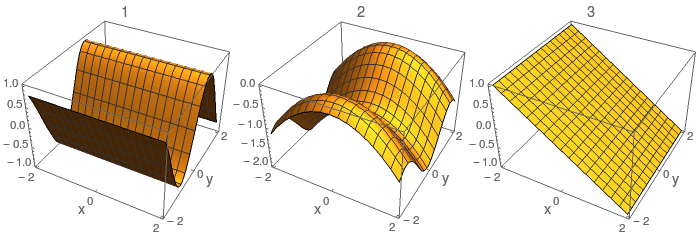Diferenças entre edições de "Gráficos derivadas parciais"
| (Há uma edição intermédia do mesmo utilizador que não está a ser apresentada) | |||
| Linha 7: | Linha 7: | ||
*ANO: 1 | *ANO: 1 | ||
*LINGUA: pt | *LINGUA: pt | ||
| − | *AUTOR: | + | *AUTOR: Ana Moura Santos e Miguel Dziergwa |
| − | *MATERIA PRINCIPAL: | + | *MATERIA PRINCIPAL: Derivadas parciais |
| − | *DESCRICAO: | + | *DESCRICAO: Identificar gráficos das funções derivadas parciais |
| − | *DIFICULDADE: | + | *DIFICULDADE: * |
*TEMPO MEDIO DE RESOLUCAO: 15 mn | *TEMPO MEDIO DE RESOLUCAO: 15 mn | ||
| − | *TEMPO MAXIMO DE RESOLUCAO: | + | *TEMPO MAXIMO DE RESOLUCAO: 20 mn |
| − | *PALAVRAS CHAVE: | + | *PALAVRAS CHAVE: função de 2 variáveis, gráfico de uma função de 2 variáveis, funções derivadas parciais |
</div> | </div> | ||
</div> | </div> | ||
Edição atual desde as 20h14min de 23 de março de 2018
Metadata
- CONTEXTO : Primeiro ciclo universitário
- AREA: Matemática
- DISCIPLINA: Calculo diferencial e integral 2
- ANO: 1
- LINGUA: pt
- AUTOR: Ana Moura Santos e Miguel Dziergwa
- MATERIA PRINCIPAL: Derivadas parciais
- DESCRICAO: Identificar gráficos das funções derivadas parciais
- DIFICULDADE: *
- TEMPO MEDIO DE RESOLUCAO: 15 mn
- TEMPO MAXIMO DE RESOLUCAO: 20 mn
- PALAVRAS CHAVE: função de 2 variáveis, gráfico de uma função de 2 variáveis, funções derivadas parciais
De seguida estão representados três gráficos, numerados de 1 a 3. Um é o gráfico duma função escalar nas duas variáveis reais x e y, da forma \(\text{f}\left(\begin{array}{c}x\\y\\\end{array}\right)=\text{f}_1\text{(x)+}\text{f}_2\text{(y)}\), outro é o gráfico da derivada parcial em ordem a x dessa função e o outro da derivada parcial em ordem a y da mesma função.
Qual a correspondência correcta?
A)1 corresponde a \(\text{f}\left(\begin{array}{c}x\\y\\\end{array}\right)\) , 2 corresponde à derivada \(\text{D}_1\text{f}\left(\begin{array}{c}x\\y\\\end{array}\right)\) e 3 corresponde à derivada \(\text{D}_2\text{f}\left(\begin{array}{c}x\\y\\\end{array}\right)\)
B)1 corresponde a \(\text{f}\left(\begin{array}{c}x\\y\\\end{array}\right)\) , 3 corresponde à derivada \(\text{D}_1\text{f}\left(\begin{array}{c}x\\y\\\end{array}\right)\) e 2 corresponde à derivada \(\text{D}_2\text{f}\left(\begin{array}{c}x\\y\\\end{array}\right)\)
C)2 corresponde a \(\text{f}\left(\begin{array}{c}x\\y\\\end{array}\right)\) , 1 corresponde à derivada \(\text{D}_1\text{f}\left(\begin{array}{c}x\\y\\\end{array}\right)\) e 3 corresponde à derivada \(\text{D}_2\text{f}\left(\begin{array}{c}x\\y\\\end{array}\right)\)
D)2 corresponde a \(\text{f}\left(\begin{array}{c}x\\y\\\end{array}\right)\) , 3 corresponde à derivada \(\text{D}_1\text{f}\left(\begin{array}{c}x\\y\\\end{array}\right)\) e 1 corresponde à derivada \(\text{D}_2\text{f}\left(\begin{array}{c}x\\y\\\end{array}\right)\)
E)3 corresponde a \(\text{f}\left(\begin{array}{c}x\\y\\\end{array}\right)\) , 1 corresponde à derivada \(\text{D}_1\text{f}\left(\begin{array}{c}x\\y\\\end{array}\right)\) e 2 corresponde à derivada \(\text{D}_2\text{f}\left(\begin{array}{c}x\\y\\\end{array}\right)\)
F)3 corresponde a \(\text{f}\left(\begin{array}{c}x\\y\\\end{array}\right)\) , 2 corresponde à derivada \(\text{D}_1\text{f}\left(\begin{array}{c}x\\y\\\end{array}\right)\) e 1 corresponde à derivada \(\text{D}_2\text{f}\left(\begin{array}{c}x\\y\\\end{array}\right)\)
Para obter o zip que contém as instâncias deste exercício clique aqui(graficosDP)
Se deseja obter o código fonte que gera os exercícios contacte miguel.dziergwa@ist.utl.pt
